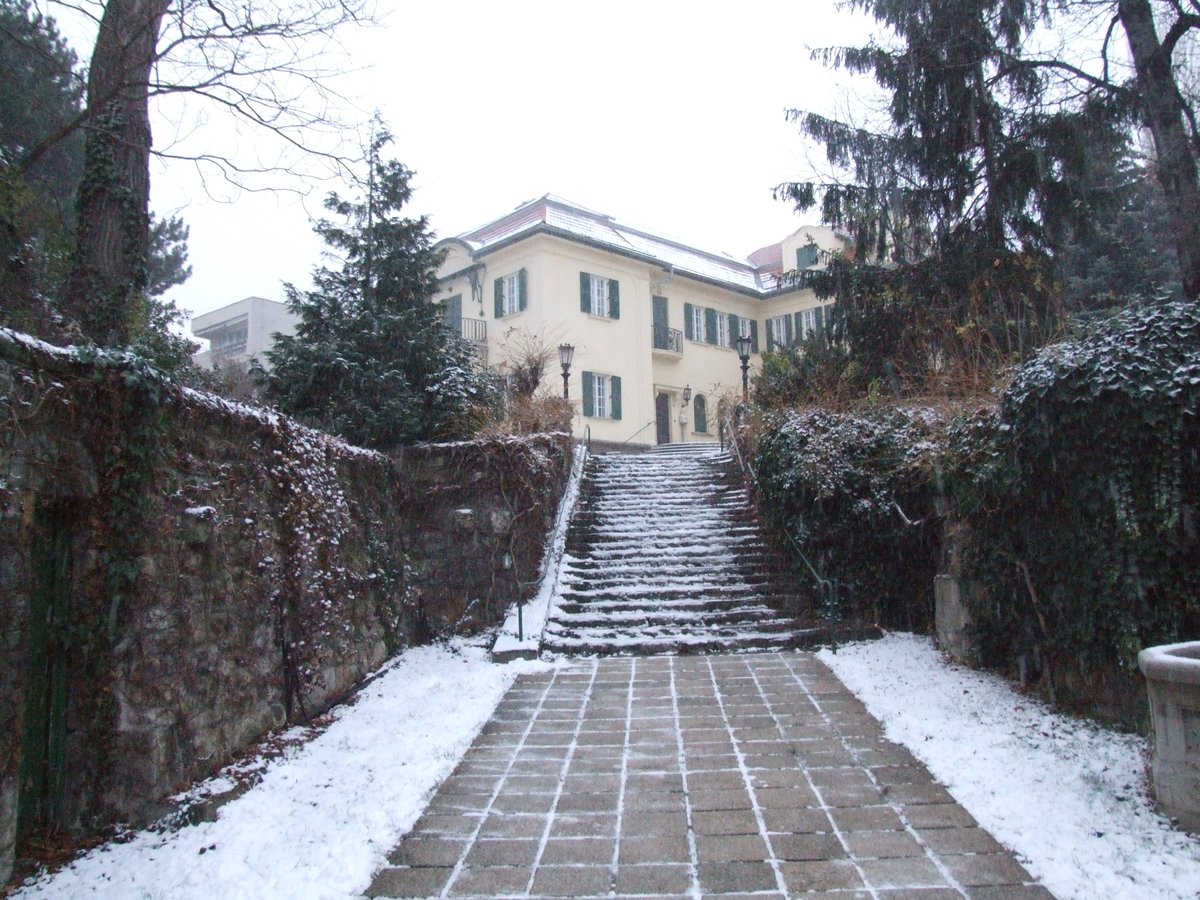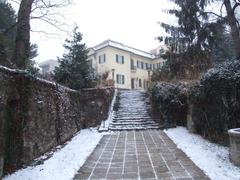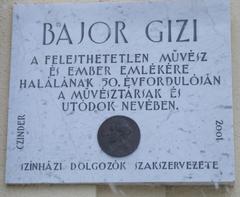
Gizi Bajor Actor’s Museum Budapest: Visiting Hours, Tickets, and Comprehensive Guide
Date: 14/06/2025
Introduction
The Gizi Bajor Actor’s Museum (Bajor Gizi Színészmúzeum) is one of Budapest’s most remarkable cultural destinations, dedicated to Hungary’s theatrical legacy and the life of celebrated actress Gizi Bajor. Set in a tranquil corner of the Buda hills, this neobaroque villa offers not only an intimate look at Bajor’s personal world but also a fascinating exploration of nearly two centuries of Hungarian performing arts. With exhibitions ranging from personal memorabilia to full-scale theatrical reconstructions, the museum is an unmissable stop for theater aficionados, history lovers, and anyone seeking to experience Budapest’s artistic heritage beyond the usual tourist trails. (oszmi.hu, pestbuda.hu, welovebudapest.com)
History and Cultural Significance
Origins and the Villa’s Story
The museum occupies a historic neobaroque villa at Stromfeld Aurél utca 16, originally acquired in 1928 by Bajor’s brother, Rudolf Beyer. Architect Béla Országh transformed it into a grand residence, and from 1933, it became Gizi Bajor’s home. This villa soon evolved into a meeting place for Budapest’s theatrical elite and, during World War II, a safe haven for those fleeing persecution. (pestbuda.hu)
Gizi Bajor’s Legacy
Gizi Bajor (1893–1951) was a leading actress at the National Theatre, celebrated for her emotional depth and stage artistry. After her death in 1951, the villa was transformed into a museum by fellow actress Hilda Gobbi in 1952. Today, it stands as a testament to Bajor’s influence and Hungary’s broader theatrical heritage, with the villa itself recognized as a landmark of early 20th-century architecture.
Museum Development
From its modest beginnings with a single exhibition room, the museum has expanded to fill the entire villa. It now houses a substantial archive, including costumes, documents, photographs, and set models, offering a comprehensive chronicle of Hungarian theater’s evolution. The museum’s role as both a guardian of history and an active cultural hub makes it a cornerstone of Budapest’s artistic community.
Museum Exhibitions and Collections
Permanent Exhibitions
- “A Beautiful House in the Middle of a Big Park”: This exhibition recreates the life and times of Gizi Bajor, featuring her personal belongings, costumes, stage props, and memorabilia. The lovingly preserved rooms and original National Theatre royal box furniture immerse visitors in the ambiance of Hungary’s theatrical golden age.
- “Between the Coulisses”: This thematic journey reveals the creative processes behind Hungarian theater—from operetta to contemporary drama—through original props, costumes, set designs, and rare archival materials. (Bajor Gizi Museum history)
Temporary and Thematic Exhibitions
The museum regularly hosts special exhibitions on notable performers, directors, genres, or theatrical milestones. These often include multimedia displays and interactive elements to engage visitors of all ages.
- Recent Highlight: The Tompos Kátya (1983–2024) retrospective (Feb 28–Sep 28, 2025) celebrates the late actress’s versatile career, featuring photos, costumes, and personal archives. (Learn more about the exhibition)
Special Collections and Archives
- Theatre Collection: Includes original costumes, stage props, set models, photographs, and manuscripts, accessible for research by appointment. (Theatre Collection details)
- Dance Archive: Chronicles the evolution of Hungarian dance theater.
- Puppet Collection (Bábtár): Features puppets, marionettes, stage designs, and recordings, highlighting the diversity of Hungarian theatrical expression.
Visitor Experience
Exhibition Design and Setting
The museum’s villa is carefully maintained to reflect its historical period, enhancing the authenticity of the experience. Visitors can explore:
- The original living spaces and gardens
- The reconstructed National Theatre royal box
- Thematic rooms dedicated to Hungarian operetta, rehearsal life, and more
- Attic and basement exhibits exploring the villa’s wartime history
Interactive and Educational Programs
Guided villa walks (“cellar to attic” tours), workshops, family activities, and lectures are offered throughout the year, making the museum engaging for all ages. (Villa Walk info)
Family-Friendly Features
Children can enjoy hands-on activities like costume dress-up, treasure hunts, and exploring interactive theater models.
Practical Visitor Information
Opening Hours
- Tuesday to Sunday: 10:00 AM – 6:00 PM
- Closed: Mondays and national holidays
- Note: Some sources list alternative hours (e.g., Wed–Sun, 2–6 PM); check the museum’s official website for current details.
Tickets and Admission
- Adults: 1,200–1,500 HUF (varies by exhibition or program)
- Students/Seniors: 600–1,000 HUF
- Children under 6: Free
- Family tickets: 2,500 HUF (check for availability)
- Free entry on Hungarian national holidays and during special events like the Night of Museums.
- Purchase tickets onsite or online via the official website.
Accessibility
- The ground floor is wheelchair accessible; upper floors may have limited access due to the villa’s historic architecture.
- Contact the museum for specific accommodations.
Getting There
- Location: Stromfeld Aurél utca 16, Budapest 1124 (Google Maps)
- Public Transport: Buses 27, 105, 112; tram 59 (Márton Áron tér); or bus 8/8A (Gizi Bajor utca stop).
- Parking: Limited street parking; use public transport if possible.
Visitor Services
- Guided Tours: Available in Hungarian and English by appointment; recommended for deeper insight.
- Audio Guides: English versions available for independent visitors.
- Gift Shop: Offers theater-themed souvenirs.
- Café: Not available onsite; nearby cafés are within walking distance.
Nearby Attractions
- Normafa Park: For hiking and panoramic city views.
- János Hill and Elizabeth Lookout Tower: Popular for outdoor activities.
- Hospital in the Rock Museum: Fascinating WWII history.
- Children’s Railway: Unique family adventure.
Combine your museum experience with local green spaces and cultural sites for a full day in Budapest’s 12th district.
Special Events and Programs
- Night of Museums: Annual festival in June with free/discounted entry and shuttle service. (travellingmandala.com)
- Temporary Exhibitions: Regularly updated—check the website or Facebook page for news.
- Theatrical Evenings and Memorials: Occasional commemorations and performances.
Visitor Tips
- Allow 1.5–2 hours to explore thoroughly.
- Check for special exhibitions or guided tours in advance.
- Photography is permitted without flash; ask staff about any restrictions.
- Bring a Hungarian-speaking friend or use the English audio guide for the best experience.
- Explore the villa’s gardens for a peaceful break.
Frequently Asked Questions (FAQ)
Q: What are the visiting hours?
A: Tuesday–Sunday, 10:00 AM–6:00 PM (closed Mondays). Always check the official website for updates.
Q: How much are tickets?
A: Adults: 1,200–1,500 HUF; students/seniors: 600–1,000 HUF; children under 6: free; family tickets: 2,500 HUF.
Q: Is the museum wheelchair accessible?
A: The ground floor is accessible; upper floors have limited access. Contact the museum for specific needs.
Q: Are guided tours available?
A: Yes, in Hungarian and English by appointment.
Q: Can I take photos inside?
A: Photography without flash is generally allowed.
Q: Is the museum suitable for children?
A: Yes—family-friendly exhibits and activities are available.
Q: Is there a café or restaurant?
A: No café onsite, but options are nearby and visitors can enjoy the garden.
Visitor Reviews
Guests consistently praise the museum’s intimate atmosphere, helpful staff, and the authentic preservation of Hungary’s theatrical golden age. The villa’s garden and the richness of the collections offer a unique, immersive cultural experience. (welovebudapest.com, helpmecovid.com)
Final Tips and Summary
The Gizi Bajor Actor’s Museum provides an enriching exploration of Hungarian culture, from its immersive exhibitions and authentic villa setting to interactive family programs and special events. Its role as both a living archive and cultural hub makes it a profound destination for locals and visitors alike. For up-to-date details, special programs, and audio guides, visit the official website and consider downloading the Audiala app.
Useful Links and Further Reading
- Official Museum Website
- Budapest Public Transport Info
- Related Article on Hungarian Theater
- Museum History and Exhibitions
- Welovebudapest Feature
- PestBuda Article
- Temporary Exhibition Info
- Villa Walk Event
- Night of Museums in Budapest









































































































































































